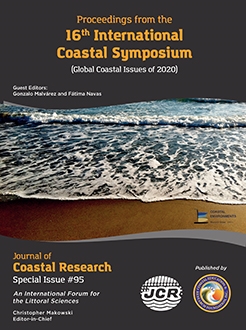Mouragues, A.; Bonneton, P.; Castelle, B.; Marieu, V.; Barrett, A.; Bonneton, N.; Detand, G.; Martins, K.; McCarroll, J.; Morichon, D.; Poate, T.; Rodriguez Padilla, I.; Scott, T., and Sous, D., 2020. Field observations of wave-induced headland rips. In: Malvárez, G. and Navas, F. (eds.), Global Coastal Issues of 2020. Journal of Coastal Research, Special Issue No. 95, pp. 578–582. Coconut Creek (Florida), ISSN 0749-0208.
Most of rip-current field experiments have focused on persistent rips along rip-channeled sandy beaches or transient rips along reasonably alongshore-uniform surf-zone morphology, while experiments on rip flowing against structures are scarce. In October 2018, a 3-week field experiment was performed at Anglet beach, SW France, aiming at examining the dynamics of high-energy rip currents in complex settings. The beach is barred with prominent inherited geology, characterized by the presence of a 500-m headland and a natural submerged reef. A large array of in-situ instruments was deployed to capture the temporal and spatial variability of rip flow circulations, including ADCPs, surf-zone drifters and video monitoring. The latter allowed to identify a wide range of rip-flow patterns. Among these patterns, a high-intensity rip current flowing against the headland was a dominant feature for obliquely incident waves. Such a boundary rip current was driven by the deflection of the longshore current against the headland, peaking at 0.7 m/s (5-min time- and depth-averaged) 800-m offshore in 12-m depth for a moderate storm event with 4-m obliquely incident waves. Very-low-frequency (O(1h) and O(30min)) fluctuations of this rip current were observed around low tide. Measurements of the vertical structure of the rip reveal that the deflection rip was more vertically-sheared as the water depth increases, with higher velocities near the surface, which is typical of a theoretical rip head structure.





